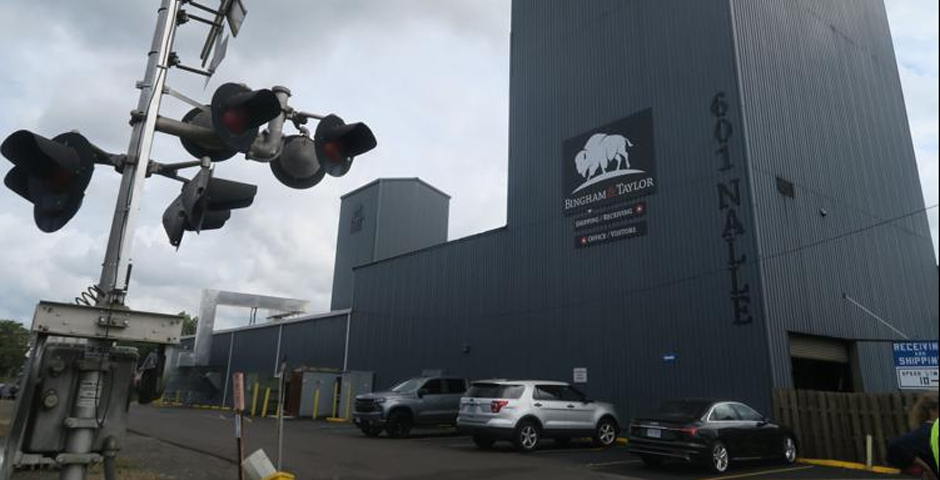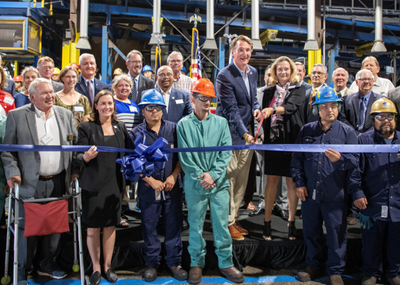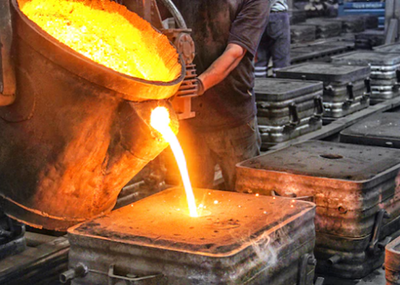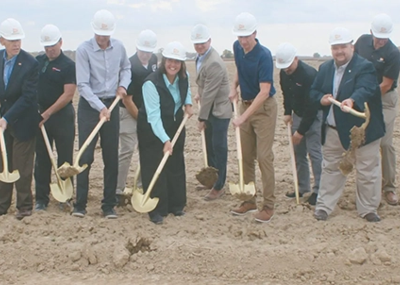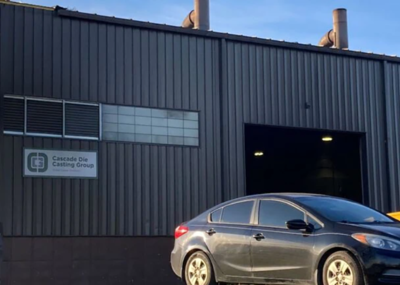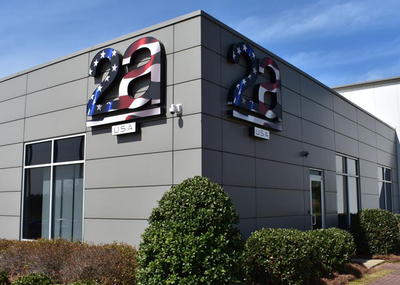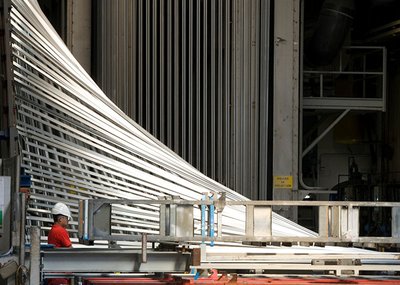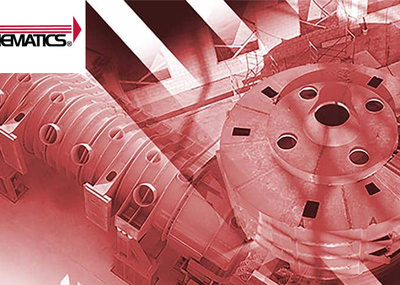Gov. Glenn Youngkin was in town for the special occasion, a ribbon cutting ceremony celebrating a $23 million expansion and modernization at the female-owned plant typically closed on Fridays.
The governor, an American businessman, touted domestic production of goods.
“Manufacturing is coming back to Virginia and I believe strongly that 'Made in America' means made in Virginia,” he said. “A celebration of partnering, the history here is one I am honored to share, operating in Culpeper since 1946, Bingham & Taylor has had their flagship plant right here in the commonwealth for 77 years.
"That partnership has withstood the test of time with expansions twice for an injection molding plastics plant, enabling it to be at the heart of our gas and water industries, building a Virginia for the future.”
Bingham & Taylor, founded 1849 in Buffalo, New York, was the first company to create a plastic valve box, manufacturing custom cast iron and plastic products to meet the needs of its customers, Youngkin said.
“This company, for 175 years, has understood that innovation and excellence and passion for what customers need come together to create a great company that grows, comes great opportunities, we are here at the tail end of of an extraordinary expansion,” the governor said.
Most of the investment was to ready the plant to switch from a coal-burning furnace to an electric melt furnace, cutting carbon emissions produced by the site by 98%, according to Culpeper Tourism and Economic Development Director Paige Read.
“This is a true testament to collaboration, to having likeminded partners on the vendor side and the contractor side, to that collaboration from the client side as well, as Bingham & Taylor is coming on up on their 175th anniversary,” she said in remarks Friday.
Read was part of the town team that helped facilitate the cleaner, greener switch to electric at the foundry through Town of Culpeper Light & Power.
The town electric distribution company built an electrical circuit from its Chandler Street facility, servicing a mini substation the town built behind the massive operation across town. Light & Power Director Mike Stover said Bingham & Taylor is the town’s largest power customer. “We sat down and talked with them 20 years ago about this, it never went anywhere, been in the works for quite a while. I’m happy to see it happen.”
The electric-powered melt furnace is better for the environment and the community, Stover stated. Councilwoman Meaghan Taylor, who has lived in the area of the foundry for years, agreed, recalling no more black soot covering their porches since the switchover.
The electric melt furnace at Bingham & Taylor went live this past spring, Stover said. The town council passed a new industrial power utility rate class that made the environmental upgrade affordable, Read said in a phone call.
The expansion generated 45 new jobs, an entire second shift with 32 hourly positions and 13 professional/managerial positions, Read said. She noted the workforce at the plant is 60% Latino.
Bingham & Taylor workers lined up by the dozens for the ribbon cutting on their day off, wearing hard hats and safety goggles with button-up cotton uniforms in shades of blue, standing behind the governor as he spoke about bringing manufacturing jobs back to Virginia.
It was a show of force for American manufacturing at the facility employing around 165 employees, a figure provided by Steve McGuff, chief of manufacturing, a consultant for the company.
Bingham & Taylor in Culpeper will produce 1.5 million parts per year, a turnout of 12-13 million pounds, he said, of their manufactured on-site inventory serving public utilities, including valve covers, manhole covers, cast iron frame, meter covers and valve box covers, in both cast iron and plastic components.
“It’s the highest we have ever been able to do because the old system limited how many pounds we could melt,” McGuff said. “The new system could potentially do 40 million pounds. We are only using a quarter of the capacity on-site … we’re growing.”
Bingham & Taylor President Laura Grondin has been CEO since 1999, appointed by her father, now in his 90s, who she thanked at the ribbon cutting for having in faith in her.
“Today we are a 100% female owned company,” she said. “Thank you to the people from the town of Culpeper, those who helped us set up our electric run furnace, we have a substation built here and really provided the electricity we need to operate these furnaces … I am very proud to stand before you on the eve of our 175th anniversary and to celebrate our electric melt.”
The $23 million also invested in other equipment, Grondin added.
“As much work as we have done to modernize this foundry, we have more work to do and we will keep going."
Grondin asked the audience to support domestic manufacturing every chance they get.
“We provide products that help to bring clean drinking water into people’s homes,” she said. “The EPA estimates, in the next 20 years, it is going to cost $625 billion to repair and replace water systems across the U.S. We have created a product called the Bison that will directly compete with imported products — it is, in fact, a better product."
Bingham & Taylor is a job creator, the CEO said, and they are going to add more jobs because they are going to get more work. The company is a sustainability creator, Grondin added, noting most of what goes into products from the factory is made of recyclable material.
The No. 1 recycled material melted into utility valve parts at the foundry are old brake rotors. Bingham & Taylor is an industry leader, Grondin said.
“In the 1850s, we invented the first Buffalo valve box, that box is still in being put into the ground today, (we are the) original patentee, Bison box is a combination of cast iron and plastic,” she said.
“It defeats the import product coming into this country and it is our intention that we spread it as far and wide as we can and 100% of those inputs will be made in the state of Virginia.”
The company president stated she is always walking around looking down at the sidewalk for their products. “We are going to put as many of those in the ground as we possibly can."
Tours of the foundry were well-attended, with employees at various stations explaining how the parts are made. Starting the process, the furnace is heated to 2,850 degrees, hotter than the center of a volcano, turning brake rotors to liquid metal for reshaping down the assembly line from the pour zone, following the flow of iron, according to a first stop on the tour.
Second shift superintendent Doug Barton of Louisa County was among tour presenters down the line. He works 2 p.m. to 12:30 a.m. at the plant.
“Mr. Youngkin was talking about the jobs that had been created, 40 plus — 40 of them work at night with me. That furnace has supplied an entire shift of employment, not just expanded, but an entire shift of new employees in one year,” Barton said.
The foundry shift leader was working in art and sculpture before coming to Bingham & Taylor. Barton mentioned an industrial background.
“This is easy for me. I'm used to it, I used to make more complicated stuff, it’s fine … this entire facility is running for 20 hours per day, double shifts, we’re trying, pushing it to the max — we need more orders."
Tour presenter Wayne Lee of Culpeper, an 18-year employee, runs two shifts at the foundry, in the molding department. The plant uses a monorail system for the shaping of the iron into parts, he said.
Sand is used for making the molds of the desired parts that are poured into the mold then carefully removed, leaving a negative impression.
“Once the iron solidifies, you have a finished product — one pour per mold,” the shift supervisor said. Lee noted they recycle 147 tons of sand per year. He said his hours vary at the growing plant. “Some weeks is 80 hours, some is 40 hours."
Chief engineer Sahil Makwana of Herndon participated as a tour presenter from the lab, speaking about testing the cast iron so it meets standards. He said he loved the work.
“I have been in this industry since after college, metal, it’s my passion for seven years,” said Makwana, noting his dad was in manufacturing. “I learned it during high school, started working in India, worked couple foundries over there, then took my masters at the University of Akron in Ohio.”
The modernization at Bingham & Taylor has reduced injuries on the job by 90%, Gov. Youngkin said in his remarks at the ribbon cutting, noting the company's commitment to improving the environment.
“What a resume,” he said. “Going to be here for another 175 years right here in the heart of Culpeper. Talent is at the heart of everything. My breath was taken back by the talent around the room, the commitment you all have, your hard work, passion, professionalism is what distinguishes you, that talent pipeline, from 28 years to one year, mentoring the new ones, all working together for the next generation of great labor.”
Virginia should have a tremendous dedication to make sure its schools are delivering for the next generation and that parents are deeply engaged, the governor said, and that there is an opportunity to forge a path to the future.
“This is what education is all about and that’s what we’re standing for in the commonwealth of Virginia. Job well done."
Source: www.starexponent.com

